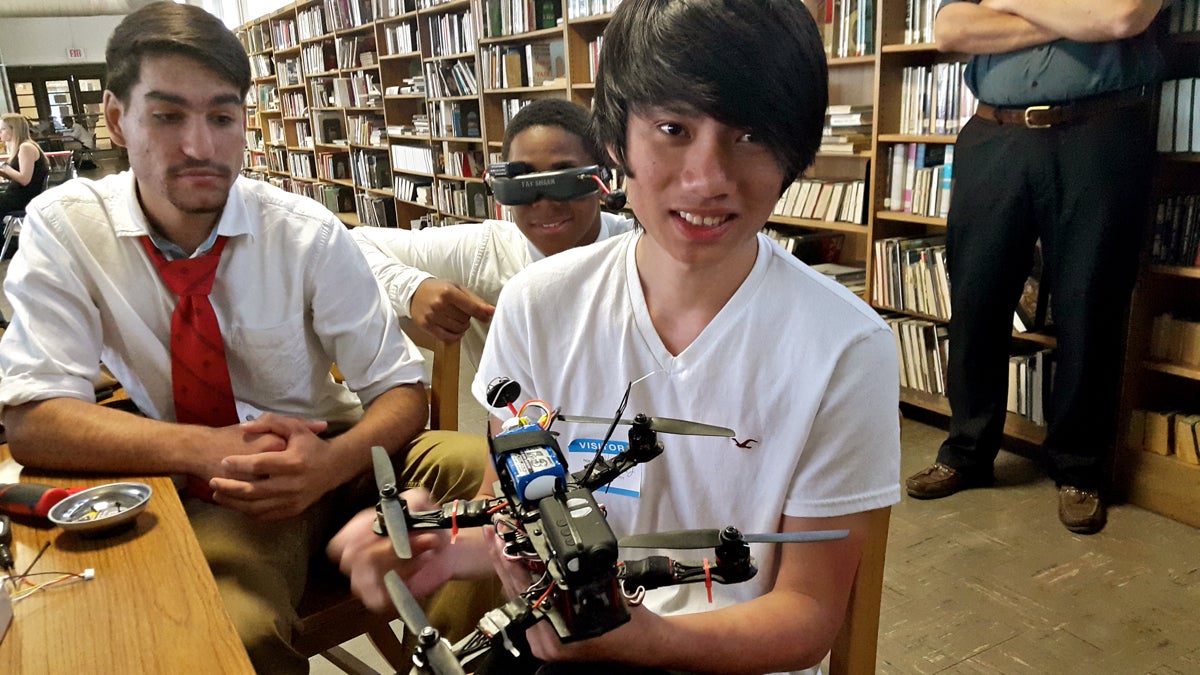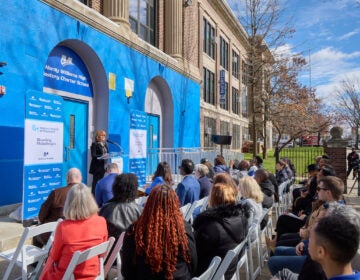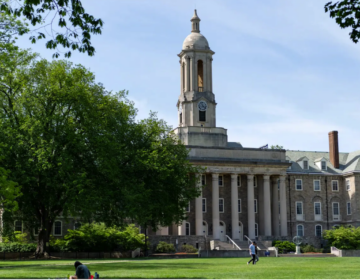Dream act — what one Philly public school would do if Wolf has his way
Listen
Hoang Bui, 20, shows off his quad-copter during a "hackathon" at Northeast High School. (Laura Benshoff/WHYY)
What would you do with two and a half million dollars? Or, $2,447,020 to be exact.
That’s how much money Northeast High School would get if the School District of Philadelphia gets all of the $265 million in additional resources proposed by Gov. Tom Wolf and Mayor Michael Nutter.
Not saying it will happen, but what if ….?
Both men face an uphill battle to get those numbers through the General Assembly and City Council respectively, but enough with the politicians for a minute.
WHYY/NewsWorks wanted to know what a public school might do with the additional dollars if they ever arrived, so we went to Northeast High.
The tale the numbers tell
Northeast is Philadelphia’s biggest high school. Nearly 3,000 students attend a school designed for 2,400. And it’s been around, in one building or another, for more than a hundred years.
“We don’t say, ‘You’re the graduating class of 2015,” said Principal Sharon McCloskey. “You’re class 174,” or the 174th class to graduate from Northeast.
It’s also diverse. Student at Northeast speak 57 different languages, according to McCloskey.
Many Philadelphia public schools are diverse, but few fit this next statement: Northeast is a true comprehensive high school. That means it offers different courses of study to satisfy all types of students, from those who want to focus on academics to those interested in career skills.
Students can learn to play classical music, or take business classes. “We even have kids designing video games,” said McCloskey.
But it has to look outside of its budget to provide some of those niche programs.
“We have to beg, plead, scrimp,” said Alan Wolf, who teaches business and marketing, “to get a lot of things.” He’s locked down two years of funding from the district to start a sports marketing program that will admit students from the whoele city.
“The hook is the word ‘sports’,” said Wolf, the teacher. “But they’re getting the intro to business and entrepreneurship.”
And, like many schools, Northeast has had to do without staff and supplies for over the last four years.
In McCloskey’s words, school leaders have tried to be strategic in handling short resources: “OK, some, not all of our kids take four years of language, so maybe we’ll cut a language teacher knowing that we’ll have to pick one up the following year or the year after that.”
As in many other schools, support staff were also laid off. In 2009, the school had 11 counselors; now, it has four, plus one part-time counselor.
Another area the school has cut back? Supplies. “We have some history textbooks that have Bill Clinton as the president,” said McCloskey.
Where money might go
With more money, McCloskey said, they’d be smarter about what classroom materials they’d spend it on. Here’s a hint: It wouldn’t be textbooks with Barack Obama in them.
“We would start to get Chromebooks for each 9th grade classroom … that way you’ll have the most up-to-date information, we won’t have to keep reinvesting in textbooks that will become obsolete in a year or two,” McCloskey said.
First year math teacher Jeremy Cress said he’d also like to see the creative use of technology in the classroom. “Not just, ‘Here’s a laptop’,” he said. Instead, he said he’d like to show students in his classes to “use technology as a tool.”
With more money, Northeast would also upgrade from whiteboards to wired smartboards, as well as add back 60 after-school programs.
Standing outside the school cafeteria during lunch time, McCloskey said the school would like to add support staff, including counselors and noontime aides.
“[Noontime aides are] more than just people who move kids in the hallway,” she said. “They can be that person who notices when a student is having a bad day.”
Cuts to support staff have also put more work on the backs of remaining staff.
For example, counselor Katrina Kinning saw her caseload rise from 350 students when she started in 2009 to “about 850” kids today. She said more counselors and a smaller case load would help her work on a student’s problems before they get out of hand.
“I would like to be able to do some more proactive things when I notice the kids are getting off track, before waiting for the interim or report cards,” she said. Kinning would also like to start support groups on a number of different topics she sees every day: “Grief, a lot of grief, self-esteem, motivation, girls, social skills and study skills.”
If the school district gets the full amount it seeks, Northeast would be able to hire 18 people: seven teachers, nine noontime aides and one more counselor. Most other schools aren’t as big as Northeast, so their additional funds wouldn’t buy as many new positions.
It’s still anyone’s guess how much additional money the District will receive, and the range of how much it could be is broad.
The low end, said McCloskey, is “zero.” The high is that “250 million.”
In the face of such uncertainty, school leaders still have to plan for the coming year, and McCloskey is banking on some new staff:
“Right now we’re planning — the teachers they said we were going to have next year — we’re planning and moving forward with that.”
WHYY is your source for fact-based, in-depth journalism and information. As a nonprofit organization, we rely on financial support from readers like you. Please give today.




